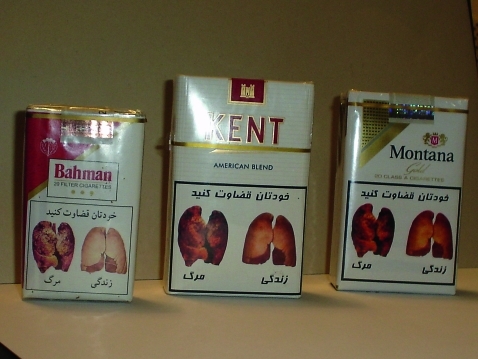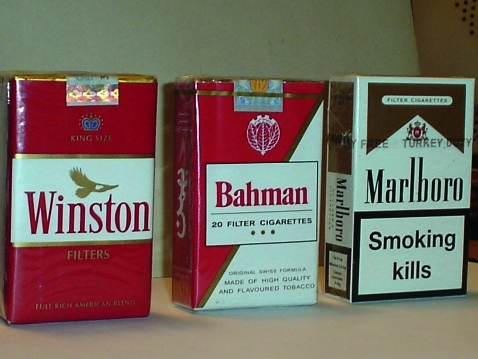Abstract
Background
Iran is one of two main target markets for tobacco smuggling in the WHO's Eastern Mediterranean Region. The Iranian government has a local tobacco monopoly but there is high demand for international brands. Informal reports show about 20% of cigarette consumption is smuggled brands. This pack survey study is the first in Iran to gather validated information on use of smuggled cigarettes.
Methods
A randomized cross-sectional household survey in Tehran in 2008–2009 of 1540 smokers aged 16–90 (83% men) was performed, including interviewer checking of cigarette packs.
Results
In all, 20.9% of cigarettes and 6.7% of domestic branded cigarettes were smuggled. A total of 60.1% of smokers preferred foreign cigarettes. There was no significant difference between consumption of illegal cigarettes by sex. (Fisher exact test p=0.61) Use of smuggled cigarettes was higher among younger smokers (p=0.01)
Conclusions
Use of illegal cigarettes is high. Tobacco control laws outlawing their sale are not being enforced.
Keywords: Cigarette, smuggling, Iran, Nicotine products
Introduction
In previous studies of global smuggling, the volume of smuggled cigarettes was estimated by calculating the difference between legal exports and legal imports.1 2 Most of the difference was due to cigarettes being channelled into the contraband market, with the major part of this sourced from large-scale smuggling. In 1995, it was estimated that between 6% and 8.5% of global cigarette consumption was smuggled.3
A 2009 report on cigarette smuggling in 84 countries estimated that 11.6% of cigarette consumption in these countries was illicit: 16.8% in low-income countries, 11.8% in middle-income countries and 9.8% in high-income countries. The total annual illicit consumption in these countries is about 657 billion cigarettes a year, 533 billion in low and middle-income countries and 124 billion in high-income countries.4
According to WHO documents,5 Iran and Iraq are the two main target markets for tobacco smuggling in the WHO's Eastern Mediterranean Region. Iran has a government-owned tobacco monopoly, but there is high demand for international brands. The prevalence of smuggled tobacco products estimated by unofficial reports made by the Ministry of Health and the Iranian Tobacco Company were 20% and 8% to 10%, respectively. In 1998, the RJ Reynolds (RJR) tobacco transnational estimated the illegal market in Iran to be 60% of the total market, with the RJR market share (mainly Winston and Magna) being about 40% of all consumption.5 In 2005 a study by the Tobacco Prevention and Control Research Center showed that about 40% of smokers in Tehran smoked smuggled cigarettes.6 The study was performed by a questionnaire filled out by smokers reporting their legal or illegal tobacco consumption. The present study is the first study performed by sighting smokers' cigarette packs.
Methods
This study was a cross-sectional household survey of smokers aged 16 and over in Tehran, conducted from September 2008 to February 2009. Smokers were included who reported having smoked for at least a year. The formula n=Z2(p)(1-P)/d2 (with a=0.05, d=0.02, Z=1.96 and P=0.20) (with n=sample size, d=half length of confidence interval 0.02, α=type 1 error 0.05, Z1-α/2=100(1-α/2)th percentile of normal distribution 1.96 and P=proportion of the population 0.20) was applied to the 22 district populations of Tehran to obtain a sample size of 1540. Sampling involved selecting a random point in each of the 22 Tehran districts and then proceeding left until the sampling quota of smokers had been interviewed.
Age, sex and occupation of the smoker, brands and daily frequency of cigarettes smoked were obtained. Smokers were asked to show the interviewers their current pack of cigarettes, which were categorised as follows: legal cigarettes: displayed special governmental labelling (figure 1), illegal cigarettes: no special governmental labelling (figure 2), domestic cigarettes: has Persian name, foreign cigarettes: has foreign name.
Figure 1.
Brands of tobacco on sale in markets in Tehran.
Figure 2.
Brands of tobacco on sale in markets in Tehran.
Results
The non-response (refusal) rate was 3.1% (48 smokers: 36 women, 12 men). A total of 1540 smokers (1284 or 83.4% men) were questioned. Ages ranged between 16–90 years, with a mean of 39.9±12.2 years; 58.4% had a high school diploma, 78.3% were married and 42.6% were self-employed. The age of commencing smoking ranged between 5–54 years (mean 21±6), the range of smoking years was 1–60 years (mean 18±12) and the number of daily cigarettes smoked was between 1–60 (mean 16.1±10.4) and smokers paid between 200–63 000 rials (mean 4382.9±3725.6) for their daily consumption (US $1 is approximately equal to 10 000 rials). Just over two in five (42.3%) lit their first cigarette within 30 min of waking. Table 1 shows the categories of cigarette consumed.
Table 1.
Categories of cigarette smoked in Tehran, 2008 to 2009
| Category | No. (%) |
| Domestic | 615 (39.9) |
| Foreign | 925 (60.1) |
| Legal | 1218 (79.1) |
| Smuggled (illegal) | 322 (20.9) |
A higher proportion of smoking women than men smoked foreign cigarettes (70.1% vs 57.9%, p<0.001). Foreign cigarettes were much more likely to be smuggled (30.4%) than domestic cigarettes (6.7%) (p<0.001). In other words, among smuggled cigarettes 12.7% were domestic and 87.3% were foreign (p<0.001). There were no statistically significant differences in the proportions of men and women who smoked smuggled cigarettes, but younger people were more likely than older people to smoke foreign brands (30 years or less: 68.6%; 31–55 years: 58.7%; >55 years: 35.4% p<0.001) and smuggled cigarettes (30 years or less: 24.5%; 31–55 years: 19.3%; >55 years: 15.3% p=0.023). Smuggled cigarettes were purchased marginally more from street sellers (23.2%) than from newspaper stands (22%) and supermarkets (19.7%) (p=0.48).
Discussion
In Tehran, foreign brands of cigarettes are in high demand, particularly by younger smokers. Many smuggled (illegal) versions of these brands are available. Unlike in other nations, smuggled brands in Iran are openly sold alongside legal, taxed brands (local and foreign) at newspaper stands and in supermarkets. This open sale of illegal cigarettes, for which no tax has been paid, is costing the Iran government large taxation losses. The Iranian Comprehensive National Tobacco Control Law has been recently approved by Parliament. From June 2009, stores were required to have tobacco sales licences, but some delay has occurred because of administrative chaos. As a result, most stores continue to offer smuggled as well as legal tobacco products. Foreign, smuggled products are also more expensive than legal products.6 The popular domestic brands Bahman and Winston International are priced at US $ 1.2 and US $ 2.0 (without tax stamps) and with the stamp at US $ 0.8 and US $1.4, respectively. This higher price is due to smokers' perceptions that illegal cigarettes are of a higher quality.
It was planned that by August 2009, guidelines from Iran's comprehensive national tobacco control law, article 7 (related to retail licensing of tobacco sale) were to be available, governing methods of supply and sale of tobacco. But unfortunately this has not happened. We are hopeful that beginning in 2010, with enactment of guidelines and licensing of sale, a better situation will be achieved.
This study provides important baseline data on consumption of illegal cigarettes that will be useful in evaluating the impact of the new guidelines.
In Iran, there are few studies on this topic; those undertaken by the Tobacco Prevention and Control Research Center relied on smoker self-reports, and found that 22.5% of the cigarettes consumed were found to be illegal.4 This does not accord with estimates from the Department of Industries or the Iranian Tobacco Company, which give estimates of 8% to 10%. This difference may be explained by the different methods of obtaining information from individuals or may be due to sampling differences. Future research should be undertaken in multiple cities across the country with a greater number of participants and by evaluating trends over several years.
This study was undertaken when the law requiring licensed cigarette sales was not being enforced. As a result, beginning in 2010 when this policy is due to be enforced, we predict smuggled tobacco sales will decrease.
Finally, we note that The Tobacco Atlas (third edition, 2009), published by the American Cancer Society, shows use of illicit tobacco in Iran to be more than 50%. The results of our study show that illegal cigarette consumption in Iran is about 20%.
What this paper adds.
Little knowledge is available about illegal cigarettes in Iran; the information is unverified and varies. As a result, this study was designed using ‘pack survey method’ to acquire detailed information and gain a basis for future research and plans.
This study showed that, unlike the results from previous studies, consumption of illegal cigarettes is 20% and most are produced abroad. A small percentage of the illegal cigarettes are domestic.
Acknowledgments
The authors would like to thank the Framework Convention Alliance for effective technical support. All authors contributed to preparing and writing the manuscript and the study was performed by Tobacco Prevention and Control Research Center.
Footnotes
Funding: This study was supported by the Masih Daneshvari Hospital.
Competing interests: None.
Patient consent: Obtained.
Ethics approval: This study was conducted with the approval of the Masih Daneshvari Hospital.
Provenance and peer review: Not commissioned; externally peer reviewed.
References
- 1.Merriman D, Yurekli A, Chaloupka FJ. How big is the worldwide cigarette-smuggling problem. In: Jha P, Chaloupka FJ. Tobacco control in developing countries. Oxford: Oxford University Press, 2000 [Google Scholar]
- 2.Joossens L, Raw M. Progress in combating cigarette smuggling: controlling the supply chain. Tob Control 2008;17:399–404 [DOI] [PMC free article] [PubMed] [Google Scholar]
- 3.Joossens L, Raw M. Tobacco smuggling and cross border shopping in Europe. BMJ 1995;310:1393–97 [DOI] [PMC free article] [PubMed] [Google Scholar]
- 4.Joossens L, Merriman D, Ross H, et al. How eliminating the global illicit cigarette trade would increase tax revenue and save lives. Paris: International Union against Tuberculosis and Lung Disease, 2009 [Google Scholar]
- 5.World Health Organization Regional Office for the Eastern Mediterranean. The cigarette “transit” road to the Islamic Republic of Iran and Iraq: illicit tobacco trade in Middle East. 2nd edn (EM/TFI/011/E/G).
- 6.Heydari G, Sharifi H, Masjedi MR, et al. What kind of cigarettes do smokers use in Tehran? Tanaffos Journal 2009;8:54–8 [Google Scholar]




